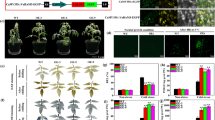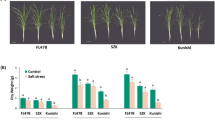Abstract
Key message
Transgenic Arabidopsis and lettuce plants overexpressing AtHSP17.8 showed ABA-hypersensitive but abiotic stress-resistant phenotypes. ABA treatment caused a dramatic induction of early ABA-responsive genes in AtHSP17.8 -overexpressing transgenic lettuce.
Abstract
Plant small heat shock proteins function as chaperones in protein folding. In addition, they are involved in responses to various abiotic stresses, such as dehydration, heat and high salinity in Arabidopsis. However, it remains elusive how they play a role in the abiotic stress responses at the molecular level. In this study, we provide evidence that Arabidopsis HSP17.8 (AtHSP17.8) positively regulates the abiotic stress responses by modulating abscisic acid (ABA) signaling in Arabidopsis, and also in lettuce, a heterologous plant when ectopically expressed. Overexpression of AtHSP17.8 in both Arabidopsis and lettuce leads to hypersensitivity to ABA and enhanced resistance to dehydration and high salinity stresses. Moreover, early ABA-responsive genes, ABI1, ABI5, NCED3, SNF4 and AREB2, were rapidly induced in AtHSP17.8-overexpressing transgenic Arabidopsis and lettuce. Based on these data, we propose that AtHSP17.8 plays a crucial role in abiotic stress responses by positively modulating ABA-mediated signaling in both Arabidopsis and lettuce. Moreover, our results suggest that stress-tolerant lettuce can be engineered using the genetic and molecular resources of Arabidopsis.







Similar content being viewed by others
References
Argyris J, Dahal P, Hayashi E, Still DW, Bradford KJ (2008) Genetic variation for lettuce seed thermoinhibition is associated with temperature-sensitive expression of abscisic acid, gibberellin, and ethylene biosynthesis, metabolism, and response genes. Plant Physiol 148:926–947
Bae W, Lee YJ, Kim DH, Lee J, Kim S, Sohn EJ, Hwang I (2008) AKR2A-mediated import of chloroplast outer membrane proteins is essential for chloroplast biogenesis. Nature Cell Biol 10:220–227
Basha E, Friedrich KL, Vierling E (2006) The N-terminal arm of small heat shock proteins is important for both chaperone activity and substrate specificity. J Biol Chem 281:39943–39952
Clough SJ, Bent AF (1998) Floral dip: a simplified method for Agrobacterium-mediated transformation of Arabidopsis thaliana. Plant J 16:735–743
Cutler AJ, Krochko JE (1999) Formation and breakdown of ABA. Trends Plant Sci 4:472–748
Endo A, Sawada Y, Takahashi H, Okamoto M, Ikegami K, Koiwai H, Seo M, Toyomasu T, Mitsuhashi W, Shinozaki K, Nakazono M, Kamiya Y, Koshiba T, Nambara E (2008) Drought induction of Arabidopsis 9-cis-epoxycarotenoid dioxygenase occurs in vascular parenchyma cells. Plant Physiol 147:1984–1993
Eyles SJ, Gierasch LM (2010) Nature’s molecular sponges: small heat shock proteins grow into their chaperone roles. Proc Natl Acad Sci USA 107:2727–2728
Guo P, Baum M, Grando S, Ceccarelli S, Bai G, Li R, Von Korff M, Varshney RK, Graner A, Valkoun J (2009) Differentially expressed genes between drought-tolerant and drought-sensitive barley genotypes in response to drought stress during the reproductive stage. J Exp Bot 60:3531–3544
Huo H, Daha P, Kunusoth K, McCallum CM, Bradford KJ (2013) Expression of 9-cis-EPOXYCAROTENOID DIOXYGENASE4 is essential for thermoinhibition of lettuce seed germination but not for seed development of stress tolerance. Plant Cell 3:884–900
Kim DH, Xu ZY, Na YJ, Yoo Y, Lee J, Hwang I (2011) Small heat shock protein Hsp17.8 functions as an AKR2A cofactor in the targeting of chloroplast outer membrane proteins in Arabidopsis. Plant Physiol 157:132–146
Kirschner M, Winkelhaus S, Thierfelder JM, Nover L (2000) Transient expression and heat-stress-induced co-aggregation of endogenous and heterologous small heat-stress proteins in tobacco protoplasts. Plant J 24:397–411
Lee KH, Piao HL, Kim HY, Choi SM, Jiang F, Hartung W, Hwang I, Kwak JM, Lee IJ, Hwang I (2006) Activation of glucosidase via stress-induced polymerization rapidly increases active pools of abscisic acid. Cell 126:1109–1120
Ma Y, Szostkiewicz I, Korte A, Moes D, Yang Y, Christmann A, Grill E (2009) Regulators of PP2C phosphatase activity function as abscisic acid sensors. Science 324:1064–1068
Pandey S, Nelson DC, Assmann SM (2009) Two novel GPCR-type G proteins are abscisic acid receptors in Arabidopsis. Cell 136:136–148
Park JS, Kim JB, Cho KJ, Cheon CI, Sung MK, Choung MG, Roh KH (2008) Arabidopsis R2R3-MYB transcription factor AtMYB60 functions as a transcriptional repressor of anthocyanin biosynthesis in lettuce (Lactuca sativa). Plant Cell Rep 27:985–994
Park SY, Fung P, Nishimura N, Jensen DR, Fujii H, Zhao Y, Lumba S, Santiago J, Rodrigues A, Chow TF, Alfred SE, Boetta D, Finkelstein R, Provart NJ, Desveaux D, Rodriquez PL, McCourt P, Zhu JK, Schroeder JI, Volkman BF, Culter SR (2009) Abscisic acid inhibits type 2C protein phosphatases via the PYR/PYL family of START proteins. Science 324:1068–1071
Rosales-Mendoza S, Soria-Guerra RE, Moreno-Fierros L, Alpuche-Solis AG, Martinez-Gonzalez L, Korban SS (2010) Expression of an immunogenic F1–V fusion protein in lettuce as a plant-based vaccine against plague. Planta 232:409–416
Scharf KD, Siddique M, Vierling E (2001) The expanding family of Arabidopsis thaliana small heat stress proteins and a new family of proteins containing alpha-crystallin domains (Acd proteins). Cell Stress Chaperones 6:225–237
Shen YY, Wang XF, Wu FQ, Du SY, Cao Z, Shang Y, Wang XL, Peng CC, Yu XC, Zhu SY, Fan RC, Xu YH, Zhang DP (2006) The Mg-chelatase H subunit is an abscisic acid receptor. Nature 443:823–826
Siddique M, Gernhard S, von Koskull-Döring P, Vierling E, Scharf KD (2008) The plant sHSP superfamily: five new members in Arabidopsis thaliana with unexpected properties. Cell Stress Chaperones 13:183–197
Song H, Fan P, Shi W, Zhao R, Li Y (2010) Expression of five AtHSP90 genes in Saccharomyces cerevisiae reveals functional differences of AtHSP90s under abiotic stresses. J Plant Physiol 167:1172–1178
Sun Y, MacRae TH (2005) Small heat shock proteins: molecular structure and chaperone function. Cell Mol Life Sci 62:2460–2476
Sun W, Bernard C, Cotte B, Montagu MV, Verbruggen N (2001) At-HSP17.6A, encoding a small heat-shock protein in Arabidopsis, can enhance osmotolerance upon overexpression. Plant J 27:407–415
Sun W, Montagu MV, Verbruggen N (2002) Small heat shock proteins and stress tolerance in plants. Biochim Biophys Acta 1577:1–9
Verslues PE, Juenger TE (2011) Drought, metabolites, and Arabidopsis natural variation: a promising combination for understanding adaptation to water-limited environments. Curr Opin Plant Biol 14:240–245
Wang ZY, Xiong L, Li W, Zhu JK, Zhu J (2011) The plant cuticle is required for osmotic stress regulation of abscisic acid biosynthesis and osmotic stress tolerance in Arabidopsis. Plant Cell 23:1971–1984
Wang W, Vinocur B, Altman A (2003) Plant responses to drought, salinity and extreme temperatures: towards genetic engineering for stress tolerance. Planta 218:1–14
Waters ER, Lee GJ, Vierling E (1996) Evolution, structure and function of the small heat shock proteins in plants. J Exp Bot 47:325–338
Wilkinson S, Davies WJ (2002) ABA-based chemical signalling: the co-ordination of responses to stress in plants. Plant Cell Environ 25:195–210
Xu ZY, Kim DH, Hwang I (2013) ABA homeostasis and signaling involving multiple subcellular compartments and multiple receptors. Plant Cell Rep 32:807–813
Xu ZY, Lee KH, Dong T, Jeong JC, Jin JB, Kanno Y, Kim DH, Kim SY, Seo M, Bressan RA, Yun DJ, Hwang I (2012) A vacuolar β-glucosidase homolog that possesses glucose-conjugated abscisic acid hydrolyzing activity plays an important role in osmotic stress responses in Arabidopsis. Plant Cell 24:2184–2199
Zeevaart JDA (1999) Abscisic acid metabolism and its regulation. In: Hooykaas PJJ, Hall MAK, Libbenga R (eds) Biochemistry and Molecular Biology of Plant Hormones. Elsevier, Amsterdam, pp 189–207
Zhu JK (2002) Salt and drought stress signal transduction in plants. Annu Rev Plant Biol 53:247–273
Acknowledgments
We sincerely appreciate Yun Jeong Na (POSTECH, Korea) for generation of transgenic lettuce. This work was supported by a grant from the Ministry of Food, Agriculture, Forestry and Fisheries, Korea (grant 609004–05–4–SB240).
Author information
Authors and Affiliations
Corresponding author
Additional information
Communicated by J. S. Shin.
Rights and permissions
About this article
Cite this article
Kim, D.H., Xu, ZY. & Hwang, I. AtHSP17.8 overexpression in transgenic lettuce gives rise to dehydration and salt stress resistance phenotypes through modulation of ABA-mediated signaling. Plant Cell Rep 32, 1953–1963 (2013). https://doi.org/10.1007/s00299-013-1506-2
Received:
Revised:
Accepted:
Published:
Issue Date:
DOI: https://doi.org/10.1007/s00299-013-1506-2




